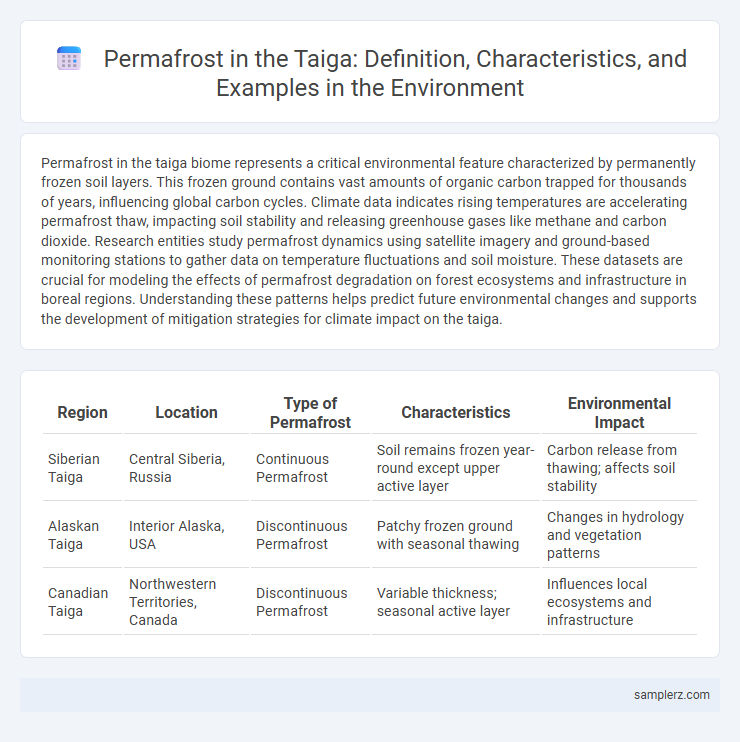Permafrost in the taiga biome represents a critical environmental feature characterized by permanently frozen soil layers. This frozen ground contains vast amounts of organic carbon trapped for thousands of years, influencing global carbon cycles. Climate data indicates rising temperatures are accelerating permafrost thaw, impacting soil stability and releasing greenhouse gases like methane and carbon dioxide. Research entities study permafrost dynamics using satellite imagery and ground-based monitoring stations to gather data on temperature fluctuations and soil moisture. These datasets are crucial for modeling the effects of permafrost degradation on forest ecosystems and infrastructure in boreal regions. Understanding these patterns helps predict future environmental changes and supports the development of mitigation strategies for climate impact on the taiga.
Table of Comparison
| Region | Location | Type of Permafrost | Characteristics | Environmental Impact |
|---|---|---|---|---|
| Siberian Taiga | Central Siberia, Russia | Continuous Permafrost | Soil remains frozen year-round except upper active layer | Carbon release from thawing; affects soil stability |
| Alaskan Taiga | Interior Alaska, USA | Discontinuous Permafrost | Patchy frozen ground with seasonal thawing | Changes in hydrology and vegetation patterns |
| Canadian Taiga | Northwestern Territories, Canada | Discontinuous Permafrost | Variable thickness; seasonal active layer | Influences local ecosystems and infrastructure |
Key Permafrost Regions in the Taiga Biome
The taiga biome hosts significant permafrost regions primarily in Siberia, Alaska, and northern Canada, where soil remains frozen for at least two consecutive years. Key permafrost zones in these areas influence ecosystem dynamics by affecting vegetation patterns, hydrology, and carbon storage. Thawing permafrost in the taiga is a critical factor in global climate change due to the release of greenhouse gases trapped within frozen organic matter.
Notable Examples of Taiga Permafrost Landscapes
The Siberian Taiga features extensive permafrost landscapes, with notable examples found in the Yakutia region, where continuous permafrost underlies vast boreal forests. In Canada, the Mackenzie River Valley in the Taiga Shield hosts significant areas of discontinuous permafrost, influencing local ecosystem dynamics and hydrology. These permafrost zones play crucial roles in carbon storage and climate regulation within subarctic forest environments.
Prominent Permafrost Sites Across Siberian Taiga
Prominent permafrost sites across the Siberian Taiga include vast regions like the Central Siberian Plateau and the Yamal Peninsula, where continuous permafrost extends deep into the soil layers, preserving ancient organic materials. The permafrost in these areas plays a critical role in regulating regional climate patterns by storing significant amounts of greenhouse gases such as methane and carbon dioxide. Thawing permafrost threatens to release these gases, impacting global climate systems and accelerating environmental change.
Canadian Taiga: Significant Permafrost Areas
The Canadian Taiga encompasses extensive permafrost regions, notably within the Northwest Territories, Yukon, and parts of northern Quebec and Manitoba. This continuous and discontinuous permafrost plays a crucial role in regulating ecosystem dynamics, carbon storage, and hydrological processes. Rising temperatures threaten the stability of these permafrost zones, potentially releasing vast amounts of greenhouse gases and altering boreal forest habitats.
Historic Instances of Permafrost in Boreal Forests
Historic instances of permafrost in boreal forests, particularly within the Siberian taiga, reveal layers of frozen soil dating back tens of thousands of years. Geological studies show that during the Last Glacial Maximum, extensive permafrost covered large parts of the northern taiga, preserving organic material and carbon deposits. These ancient permafrost layers play a critical role in today's carbon cycle, as thawing leads to the release of greenhouse gases like methane and carbon dioxide, impacting global climate systems.
Landforms Shaped by Permafrost in Taiga Ecosystems
In taiga ecosystems, permafrost significantly influences landforms such as thermokarst lakes, ice-wedge polygons, and pingos, which form due to the freeze-thaw cycles in the soil. These features create diverse microhabitats that affect hydrology and vegetation patterns across the boreal forest. The stability of taiga landscapes depends on the integrity of permafrost, which is highly sensitive to climate change, leading to altered landforms and ecosystem dynamics.
Unique Flora and Fauna Linked to Taiga Permafrost
The taiga permafrost supports unique flora such as black spruce and tamarack trees, which are specially adapted to the cold, nutrient-poor soils. Mosses, lichens, and slow-growing shrubs thrive in these frozen grounds, creating a distinctive ecological niche. Fauna like the Siberian tiger, Arctic fox, and migratory birds depend on this permafrost environment for habitat and seasonal food sources.
Human Settlements Influenced by Taiga Permafrost
Human settlements in taiga regions with permafrost, such as those found in Siberia and northern Canada, face unique challenges including ground instability and infrastructure damage due to thawing permafrost. Communities rely on specialized building techniques like elevating structures on stilts to prevent heat transfer and maintain ground integrity. Continued permafrost degradation threatens transportation networks, housing, and local economies, prompting increased research on adaptive solutions for sustainable living in these fragile environments.
The Impact of Climate Change on Taiga Permafrost Zones
Rising global temperatures have accelerated the thawing of permafrost in taiga regions, leading to the release of vast amounts of stored methane and carbon dioxide, which intensify greenhouse gas effects. The destabilization of permafrost disrupts soil structure, causing increased erosion, altered hydrology, and the collapse of ecosystems dependent on frozen ground. This process threatens biodiversity in taiga zones and poses significant challenges for infrastructure built on previously stable permafrost landscapes.
Conservation Efforts Targeting Permafrost in the Taiga
Conservation efforts targeting permafrost in the taiga focus on mitigating the effects of thawing caused by climate change, which threatens carbon storage and ecosystem stability. Initiatives include monitoring permafrost temperature changes, promoting sustainable land use, and restoring vegetation to enhance insulation and reduce soil erosion. Protecting permafrost helps preserve biodiversity and prevents the release of greenhouse gases like methane and carbon dioxide.

example of permafrost in taiga Infographic
 samplerz.com
samplerz.com